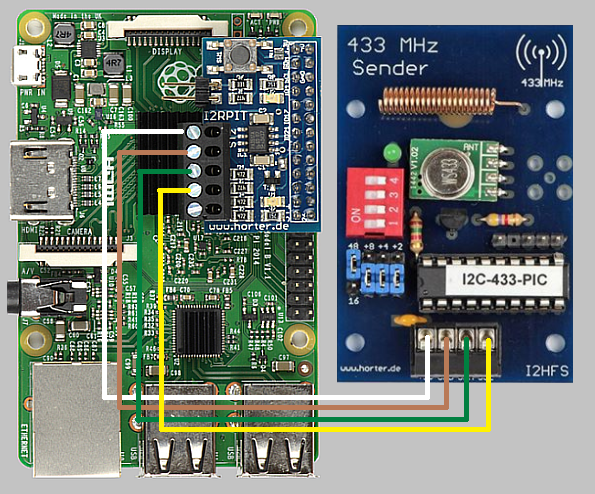diesen Beispielcode hat mir Steffen G. freundlicherweise zur Verfügung gestellt.
Mit dem Code können bis zu 160 Funksteckdosen geschaltet werden.
Das Modul hängt über einen I2C-Repeater am Raspberry-PI
Funksteckdosen mit Python schalten
Hallo Herr Horter,
ich habe für das I2HFS-Modul ein kleines Python-Skipt geschrieben, welches sie gern im Blog mit veröffentlichen können.
Das Skript heißt „i2hfs.py“.
Download:
Python-Code für Funksender (1769 Downloads)
Usage:
==============================
Horter I2HFS I2C-433 MHz Modul
==============================
Usage: ./i2hfs.py -a [ADDRESS] -p [PROTOCOL] -s [SYSCODE] -v [VALUE]
-h –help= show Usage
-a –address= I2C-ADDRESS as Integer
-p –protocol= Protocol as Integer [1-15]
-s –syscode= Systemcode as Integer-Bitmask [0-31]
-v –value= Value as Integer-Bitmask [0-255]
Es müssen alle vier Parameter angegeben werden.
Die I2C-Adresse muss als Integer angegeben werden, also 8 statt 0x08.
Als Protokoll ist nur „1“ im Moment zulässig.
Der Systemcode und der Value sind ebenfalls als Integer anzugeben. Diese Werte symbolisieren eine Bitmaske.
Hinweis:
Beim Raspberry Pi muss im Skript der Bus auf 1 gesetzt werden.
# create I2C-instance
I2HFS = smbus.SMBus(2)
Beispiel:
./i2hfs.py -a8 -p1 -s12 -v3
Adresse: 0x08
Protokoll: 1
Systemcode: DIP-Schalter 3 und 4 sind an, also
2^0 low = 0
2^1 low = 0
2^2 high = 4
2^3 high = 8
2^4 low = 0
Bytes: [ 15 0 0 15 15 ]
Value: Steckdosen mit Adresse 1 und 2 sollen geschaltet werden, also
2^3 low = 0
2^4 low = 0
2^5 low = 0
2^6 low = 0
2^7 low = 0Bytes: [ 129 130 3 4 5 6 7 8 ]
Python Beispielcode i2hfs.py
#!/usr/bin/python from __future__ import print_function import smbus import sys import time import getopt ADDRESS = '' # I2C-address as integer [8-31] PROTOCOL = '' # protocol as integer [1-15] SYSCODE = '' # system-code as integer-bitmask VALUE = '' # value as integer-bitmask def usage(): print("\n==============================") print("Horter I2HFS I2C-433 MHz Modul") print("==============================\n") print('Usage: '+sys.argv[0]+' -a [ADDRESS] -p [PROTOCOL] -s [SYSCODE] -v [VALUE]') print("\r") print("-h\t--help\t\t\tshow Usage") print("-a\t--address=\tM\tI2C-ADDRESS as Integer") print("-p\t--protocol=\tM\tProtocol as Integer [1-15]") print("-s\t--syscode=\tM\tSystemcode as Integer-Bitmask [0-31]") print("-v\t--value=\tM\tValue as Integer-Bitmask [0-255]\n") def protocol_01(): # create I2C-instance I2HFS = smbus.SMBus(2) # write protocol ############################################################ REGISTER = 0x02 DATA = [ PROTOCOL, 0x01 ] I2HFS.write_i2c_block_data(ADDRESS, REGISTER, DATA) time.sleep(0.05) # write systemcode ########################################################## REGISTER = 0x00 DATA = [ 15, 15, 15, 15, 15 ] V_STRING = bin(SYSCODE) # e.g 0b1010 V = V_STRING[2:] # e.g 1010 i = len(V) - 1 n = 0 while i >= 0: BIT = V[i:][:1] if BIT == "1": DATA[n] = 0 i = i - 1 n = n + 1 print ("\nSYSTEMCODE=\t",DATA) I2HFS.write_i2c_block_data(ADDRESS, REGISTER, DATA) time.sleep(0.05) # write value ############################################################### DATA = [ 1, 2, 3, 4, 5, 6, 7, 8 ] V_STRING = bin(VALUE) # e.g. 0b1010 V = V_STRING[2:] # e.g. 1010 i = len(V) - 1 n = 0 while i >= 0: BIT = V[i:][:1] if BIT == "1": DATA[n] = n + 1 + 128 i = i - 1 n = n + 1 print ("VALUE=\t\t",DATA,"\n") # check if module is sending REGISTER = 0x02 STATUS = I2HFS.read_i2c_block_data(ADDRESS, REGISTER, 8) while STATUS[2] != 15: # also 0xAC = 172 = ACtive time.sleep(0.01) STATUS = I2HFS.read_i2c_block_data(ADDRESS, REGISTER, 8) time.sleep(0.05) # write value only if module is not sending if STATUS[2] == 15: # also 0x0F = 15 = OFF REGISTER = 0x01 I2HFS.write_i2c_block_data(ADDRESS, REGISTER, DATA) def main(argv): global ADDRESS global PROTOCOL global SYSCODE global VALUE try: opts, args = getopt.getopt(argv,"ha:p:s:v:",["address=","protocol=","syscode=","value="]) except getopt.GetoptError: usage() sys.exit(2) for opt, arg in opts: if opt == '-h': usage() sys.exit() elif opt in ("-a", "--address"): ADDRESS = int(arg) elif opt in ("-p", "--protocol"): PROTOCOL = int(arg) elif opt in ("-s", "--syscode"): SYSCODE = int(arg) elif opt in ("-v", "--value"): VALUE = int(arg) if ADDRESS == '': usage() sys.exit(2) if VALUE == '': usage() sys.exit(2) if SYSCODE == '': usage() sys.exit(2) if PROTOCOL == '': usage() sys.exit(2) elif PROTOCOL == 1: protocol_01() else: print("\nProtocol",PROTOCOL,"not available!\n") if __name__ == "__main__": main(sys.argv[1:])


Hallo Herr Horter
Ich habe endlich mein 433MHz Funksender gelötet und heute mit etwas Fleiss meine Conrad/ Renkforce Fernbedienung ersetzen können. Die Steckdosen sind RSL366R und ich dachte ich schicke Ihnen noch die System- und ValueCodes, evtl. hilft das jemand anderem weiter:
https://docs.google.com/spreadsheets/d/19nOr0zbZeFqv7cMqax1WxTmul2a2GGQ0AK64BHT4smU/edit?usp=sharing
./i2hfs.py -a24 -p1 -s17 -v128
Eine Frage hätte ich noch: Meine Fernbedienung ist doch noch recht viel schneller im Senden der Daten. Wissen Sie evtl. warum das Funkmodul länger braucht um den Befehl an die Steckdosen zu senden?
freundlichst, Robert